Ruihai Wu
BiAssemble: Learning Collaborative Affordance for Bimanual Geometric Assembly
Jun 06, 2025Abstract:Shape assembly, the process of combining parts into a complete whole, is a crucial robotic skill with broad real-world applications. Among various assembly tasks, geometric assembly--where broken parts are reassembled into their original form (e.g., reconstructing a shattered bowl)--is particularly challenging. This requires the robot to recognize geometric cues for grasping, assembly, and subsequent bimanual collaborative manipulation on varied fragments. In this paper, we exploit the geometric generalization of point-level affordance, learning affordance aware of bimanual collaboration in geometric assembly with long-horizon action sequences. To address the evaluation ambiguity caused by geometry diversity of broken parts, we introduce a real-world benchmark featuring geometric variety and global reproducibility. Extensive experiments demonstrate the superiority of our approach over both previous affordance-based and imitation-based methods. Project page: https://sites.google.com/view/biassembly/.
DexGarmentLab: Dexterous Garment Manipulation Environment with Generalizable Policy
May 19, 2025Abstract:Garment manipulation is a critical challenge due to the diversity in garment categories, geometries, and deformations. Despite this, humans can effortlessly handle garments, thanks to the dexterity of our hands. However, existing research in the field has struggled to replicate this level of dexterity, primarily hindered by the lack of realistic simulations of dexterous garment manipulation. Therefore, we propose DexGarmentLab, the first environment specifically designed for dexterous (especially bimanual) garment manipulation, which features large-scale high-quality 3D assets for 15 task scenarios, and refines simulation techniques tailored for garment modeling to reduce the sim-to-real gap. Previous data collection typically relies on teleoperation or training expert reinforcement learning (RL) policies, which are labor-intensive and inefficient. In this paper, we leverage garment structural correspondence to automatically generate a dataset with diverse trajectories using only a single expert demonstration, significantly reducing manual intervention. However, even extensive demonstrations cannot cover the infinite states of garments, which necessitates the exploration of new algorithms. To improve generalization across diverse garment shapes and deformations, we propose a Hierarchical gArment-manipuLation pOlicy (HALO). It first identifies transferable affordance points to accurately locate the manipulation area, then generates generalizable trajectories to complete the task. Through extensive experiments and detailed analysis of our method and baseline, we demonstrate that HALO consistently outperforms existing methods, successfully generalizing to previously unseen instances even with significant variations in shape and deformation where others fail. Our project page is available at: https://wayrise.github.io/DexGarmentLab/.
RoboVerse: Towards a Unified Platform, Dataset and Benchmark for Scalable and Generalizable Robot Learning
Apr 26, 2025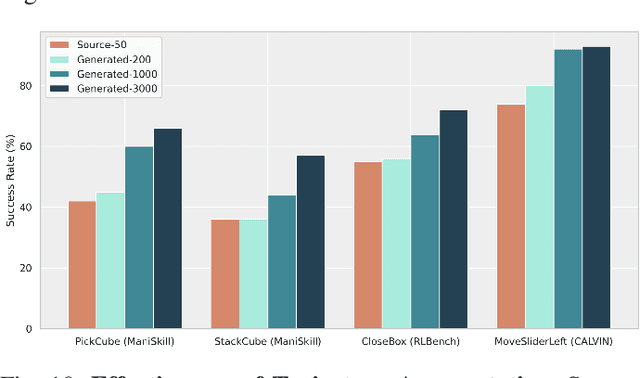
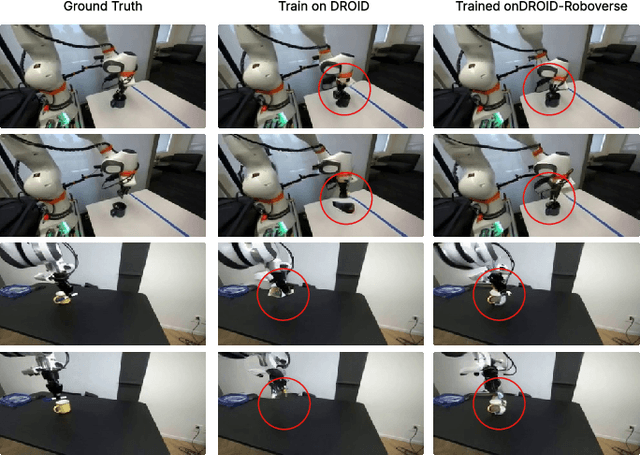
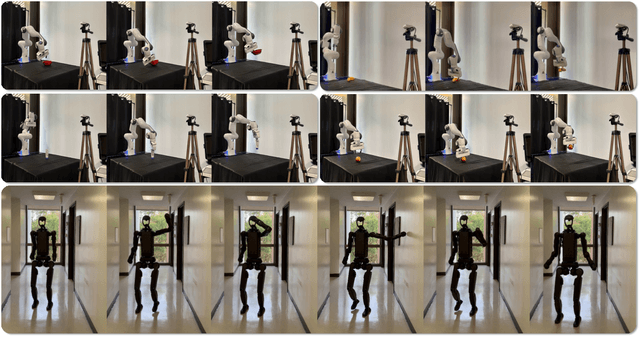
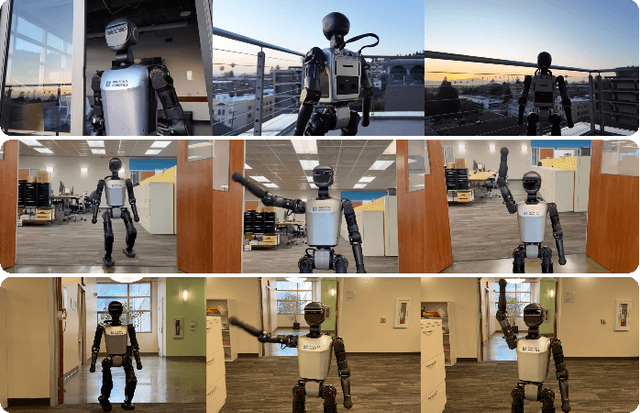
Abstract:Data scaling and standardized evaluation benchmarks have driven significant advances in natural language processing and computer vision. However, robotics faces unique challenges in scaling data and establishing evaluation protocols. Collecting real-world data is resource-intensive and inefficient, while benchmarking in real-world scenarios remains highly complex. Synthetic data and simulation offer promising alternatives, yet existing efforts often fall short in data quality, diversity, and benchmark standardization. To address these challenges, we introduce RoboVerse, a comprehensive framework comprising a simulation platform, a synthetic dataset, and unified benchmarks. Our simulation platform supports multiple simulators and robotic embodiments, enabling seamless transitions between different environments. The synthetic dataset, featuring high-fidelity physics and photorealistic rendering, is constructed through multiple approaches. Additionally, we propose unified benchmarks for imitation learning and reinforcement learning, enabling evaluation across different levels of generalization. At the core of the simulation platform is MetaSim, an infrastructure that abstracts diverse simulation environments into a universal interface. It restructures existing simulation environments into a simulator-agnostic configuration system, as well as an API aligning different simulator functionalities, such as launching simulation environments, loading assets with initial states, stepping the physics engine, etc. This abstraction ensures interoperability and extensibility. Comprehensive experiments demonstrate that RoboVerse enhances the performance of imitation learning, reinforcement learning, world model learning, and sim-to-real transfer. These results validate the reliability of our dataset and benchmarks, establishing RoboVerse as a robust solution for advancing robot learning.
GarmentPile: Point-Level Visual Affordance Guided Retrieval and Adaptation for Cluttered Garments Manipulation
Mar 12, 2025Abstract:Cluttered garments manipulation poses significant challenges due to the complex, deformable nature of garments and intricate garment relations. Unlike single-garment manipulation, cluttered scenarios require managing complex garment entanglements and interactions, while maintaining garment cleanliness and manipulation stability. To address these demands, we propose to learn point-level affordance, the dense representation modeling the complex space and multi-modal manipulation candidates, while being aware of garment geometry, structure, and inter-object relations. Additionally, as it is difficult to directly retrieve a garment in some extremely entangled clutters, we introduce an adaptation module, guided by learned affordance, to reorganize highly-entangled garments into states plausible for manipulation. Our framework demonstrates effectiveness over environments featuring diverse garment types and pile configurations in both simulation and the real world. Project page: https://garmentpile.github.io/.
MetaFold: Language-Guided Multi-Category Garment Folding Framework via Trajectory Generation and Foundation Model
Mar 11, 2025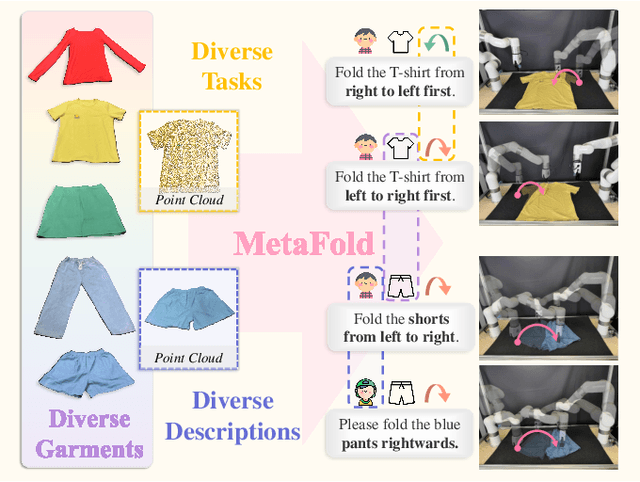
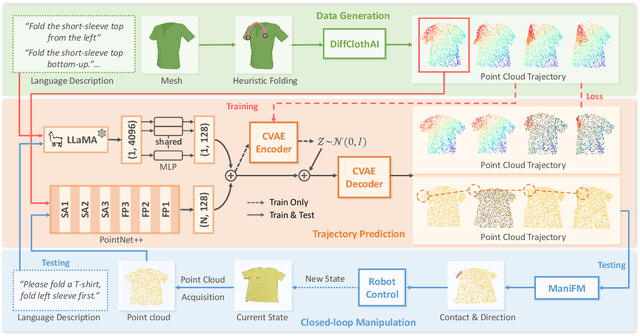
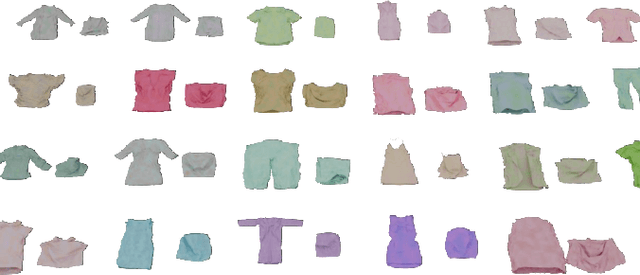
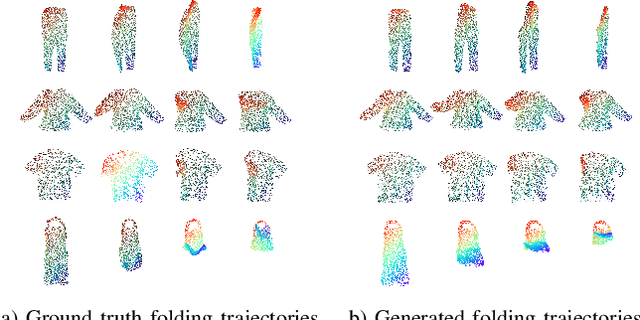
Abstract:Garment folding is a common yet challenging task in robotic manipulation. The deformability of garments leads to a vast state space and complex dynamics, which complicates precise and fine-grained manipulation. Previous approaches often rely on predefined key points or demonstrations, limiting their generalization across diverse garment categories. This paper presents a framework, MetaFold, that disentangles task planning from action prediction, learning each independently to enhance model generalization. It employs language-guided point cloud trajectory generation for task planning and a low-level foundation model for action prediction. This structure facilitates multi-category learning, enabling the model to adapt flexibly to various user instructions and folding tasks. Experimental results demonstrate the superiority of our proposed framework. Supplementary materials are available on our website: https://meta-fold.github.io/.
ManipGPT: Is Affordance Segmentation by Large Vision Models Enough for Articulated Object Manipulation?
Dec 13, 2024



Abstract:Visual actionable affordance has emerged as a transformative approach in robotics, focusing on perceiving interaction areas prior to manipulation. Traditional methods rely on pixel sampling to identify successful interaction samples or processing pointclouds for affordance mapping. However, these approaches are computationally intensive and struggle to adapt to diverse and dynamic environments. This paper introduces ManipGPT, a framework designed to predict optimal interaction areas for articulated objects using a large pre-trained vision transformer (ViT). We created a dataset of 9.9k simulated and real images to bridge the sim-to-real gap and enhance real-world applicability. By fine-tuning the vision transformer on this small dataset, we significantly improved part-level affordance segmentation, adapting the model's in-context segmentation capabilities to robot manipulation scenarios. This enables effective manipulation across simulated and real-world environments by generating part-level affordance masks, paired with an impedance adaptation policy, sufficiently eliminating the need for complex datasets or perception systems.
ET-SEED: Efficient Trajectory-Level SE(3) Equivariant Diffusion Policy
Nov 06, 2024Abstract:Imitation learning, e.g., diffusion policy, has been proven effective in various robotic manipulation tasks. However, extensive demonstrations are required for policy robustness and generalization. To reduce the demonstration reliance, we leverage spatial symmetry and propose ET-SEED, an efficient trajectory-level SE(3) equivariant diffusion model for generating action sequences in complex robot manipulation tasks. Further, previous equivariant diffusion models require the per-step equivariance in the Markov process, making it difficult to learn policy under such strong constraints. We theoretically extend equivariant Markov kernels and simplify the condition of equivariant diffusion process, thereby significantly improving training efficiency for trajectory-level SE(3) equivariant diffusion policy in an end-to-end manner. We evaluate ET-SEED on representative robotic manipulation tasks, involving rigid body, articulated and deformable object. Experiments demonstrate superior data efficiency and manipulation proficiency of our proposed method, as well as its ability to generalize to unseen configurations with only a few demonstrations. Website: https://et-seed.github.io/
GarmentLab: A Unified Simulation and Benchmark for Garment Manipulation
Nov 02, 2024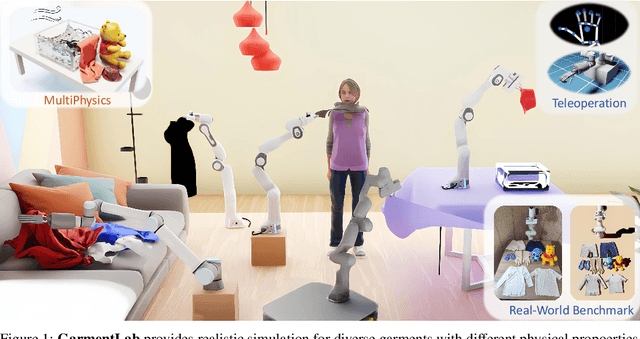

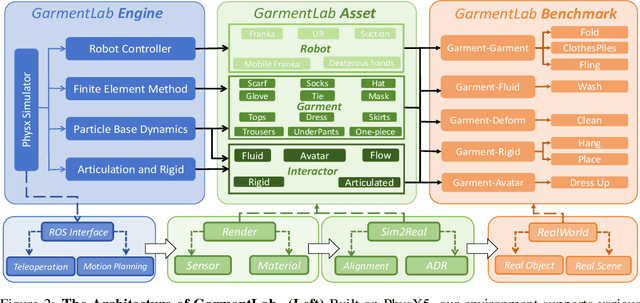

Abstract:Manipulating garments and fabrics has long been a critical endeavor in the development of home-assistant robots. However, due to complex dynamics and topological structures, garment manipulations pose significant challenges. Recent successes in reinforcement learning and vision-based methods offer promising avenues for learning garment manipulation. Nevertheless, these approaches are severely constrained by current benchmarks, which offer limited diversity of tasks and unrealistic simulation behavior. Therefore, we present GarmentLab, a content-rich benchmark and realistic simulation designed for deformable object and garment manipulation. Our benchmark encompasses a diverse range of garment types, robotic systems and manipulators. The abundant tasks in the benchmark further explores of the interactions between garments, deformable objects, rigid bodies, fluids, and human body. Moreover, by incorporating multiple simulation methods such as FEM and PBD, along with our proposed sim-to-real algorithms and real-world benchmark, we aim to significantly narrow the sim-to-real gap. We evaluate state-of-the-art vision methods, reinforcement learning, and imitation learning approaches on these tasks, highlighting the challenges faced by current algorithms, notably their limited generalization capabilities. Our proposed open-source environments and comprehensive analysis show promising boost to future research in garment manipulation by unlocking the full potential of these methods. We guarantee that we will open-source our code as soon as possible. You can watch the videos in supplementary files to learn more about the details of our work. Our project page is available at: https://garmentlab.github.io/
EqvAfford: SE(3) Equivariance for Point-Level Affordance Learning
Aug 07, 2024Abstract:Humans perceive and interact with the world with the awareness of equivariance, facilitating us in manipulating different objects in diverse poses. For robotic manipulation, such equivariance also exists in many scenarios. For example, no matter what the pose of a drawer is (translation, rotation and tilt), the manipulation strategy is consistent (grasp the handle and pull in a line). While traditional models usually do not have the awareness of equivariance for robotic manipulation, which might result in more data for training and poor performance in novel object poses, we propose our EqvAfford framework, with novel designs to guarantee the equivariance in point-level affordance learning for downstream robotic manipulation, with great performance and generalization ability on representative tasks on objects in diverse poses.
Broadcasting Support Relations Recursively from Local Dynamics for Object Retrieval in Clutters
Jun 04, 2024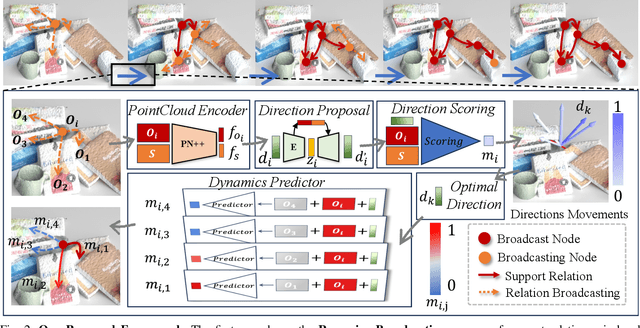
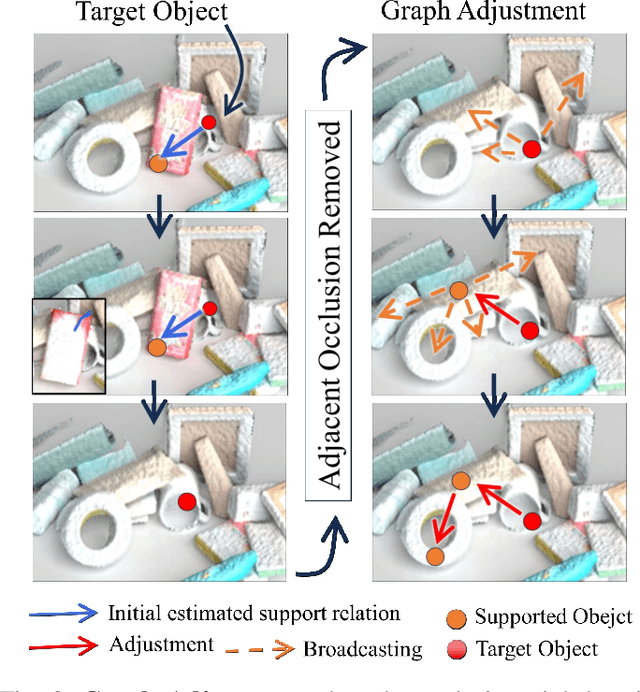
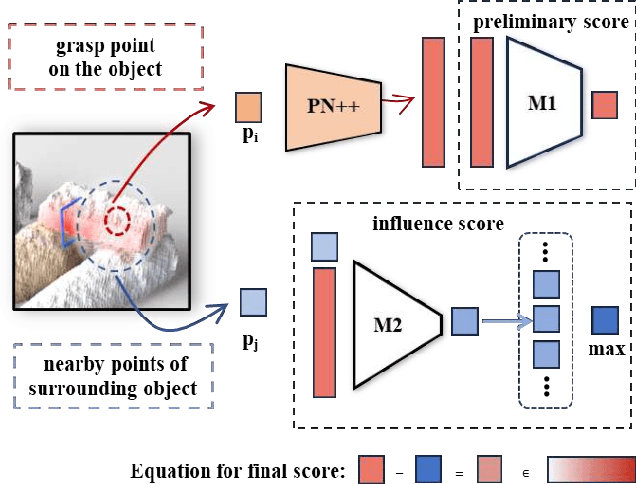

Abstract:In our daily life, cluttered objects are everywhere, from scattered stationery and books cluttering the table to bowls and plates filling the kitchen sink. Retrieving a target object from clutters is an essential while challenging skill for robots, for the difficulty of safely manipulating an object without disturbing others, which requires the robot to plan a manipulation sequence and first move away a few other objects supported by the target object step by step. However, due to the diversity of object configurations (e.g., categories, geometries, locations and poses) and their combinations in clutters, it is difficult for a robot to accurately infer the support relations between objects faraway with various objects in between. In this paper, we study retrieving objects in complicated clutters via a novel method of recursively broadcasting the accurate local dynamics to build a support relation graph of the whole scene, which largely reduces the complexity of the support relation inference and improves the accuracy. Experiments in both simulation and the real world demonstrate the efficiency and effectiveness of our method.
 Add to Chrome
Add to Chrome Add to Firefox
Add to Firefox Add to Edge
Add to Edge